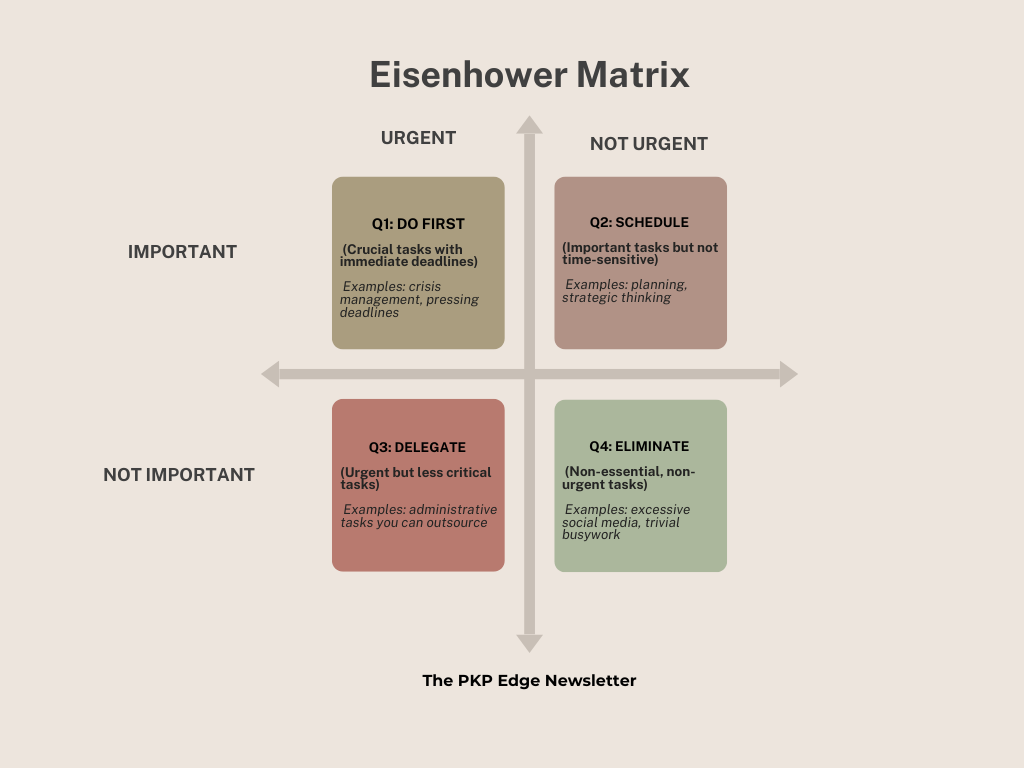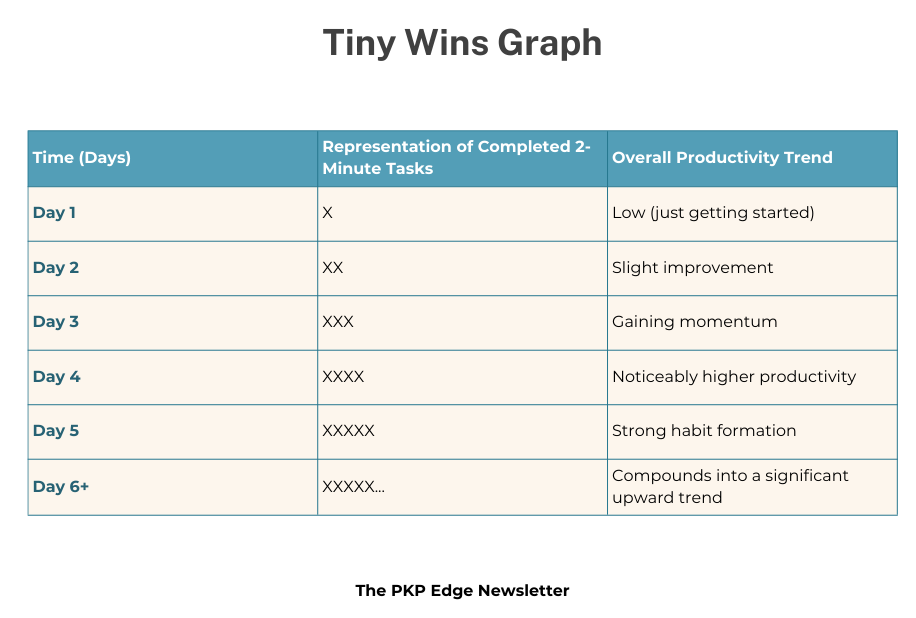The 2-Minute Rule: A Tiny Habit for Beating Procrastination
Most of us know that feeling: You see a task on your to-do list—answer an email, file a document, make a quick call—and you think, “I’ll do it later.” The next thing you know, you’ve spent half your day dodging what could have been accomplished in under two minutes.
The 2-Minute Rule might sound almost too simple, but that’s precisely why it works. When you shrink the size of a new habit to under two minutes, you reduce the mental friction that keeps you from starting. Let’s walk through why this works, how to combine it with the Eisenhower Matrix, and what the science behind small, immediate actions can teach us about beating procrastination.
What Is the 2-Minute Rule?
- If a task can be done in two minutes or less, do it now.
- Don’t wait. Taking immediate action prevents small tasks from piling up and draining your mental energy.
- For more significant tasks, commit to just two minutes of effort.
- If the job requires more time—like writing a report or tidying the entire house—start by giving it two minutes of focused work. Once you begin, it’s much easier to keep going.
Why It Works:
- Quick Wins: Small tasks completed immediately give you a burst of momentum.
- Reduces Procrastination: You skip the endless “Should I do this now or later?” loop.
- Habit Formation: Research from Duke University finds that about 40% of our daily actions stem from habits, not conscious decisions. Tiny cues trigger tiny actions, which gradually reshape your default behavior.
Eisenhower Matrix: Pairing the 2-Minute Rule with Priorities
Even though the 2-minute Rule tackles procrastination head-on, you must also ensure you’re working on the right tasks. This is where the Eisenhower Matrix comes in—a simple tool for deciding what truly deserves your attention.
Below is an ASCII diagram of the Matrix, with each quadrant labeled:
EISENHOWER MATRIX

How to Use It with the 2-Minute Rule:
- Quadrant 1 (Important & Urgent):
- If the task takes under two minutes (e.g., sending a critical email response), do it now. If it’s bigger, work on it first in your day’s schedule—but start with a two-minute push to break the ice.
- Quadrant 2 (Important & Not Urgent):
- Schedule these tasks (e.g., strategic planning, learning a new skill). Begin each session with the 2-Minute Rule to overcome the inertia of starting.
- Quadrant 3 (Not Important & Urgent):
- Delegate if possible. If a Quadrant 3 task lands on your plate and can be finished in two minutes or less, do it immediately. If not, hand it off or schedule minimal time for it.
- Quadrant 4 (Not Important & Not Urgent):
- Eliminate or minimize these tasks. They don’t support your growth. However, if it’s a tiny to-do under two minutes (e.g., unsubscribing from a junk email), do it on the spot to remove clutter.
The Science Behind Starting Small
Psychologist Teresa Amabile’s work on The Progress Principle shows that a sense of forward movement—even on tiny tasks—boosts motivation. In essence, each little victory releases a “hit” of dopamine that positively reinforces the habit of taking action. The 2-Minute Rule leverages this effect by making it easy to rack up small wins all day.
Consider Marcus, a freelance designer who dreaded sending invoices. It was an essential but tedious chore, so he’d put it off until the end of each month—then scramble. After learning the 2-Minute Rule, Marcus started sending one invoice as soon as each project wrapped. The initial “one invoice” step took under two minutes, eliminated the mental burden of waiting, and freed him from that end-of-month crunch.
Practical Tips for Applying the 2-Minute Rule
- Create a “Quick Tasks” List
- Keep a note on your desk or phone of any to-dos you suspect can be done in under two minutes. Tackle these items immediately whenever you notice them.
- Use a Timer
- For more significant tasks, set a two-minute timer just to get started. Continuing once you’re “in the flow” is more straightforward than starting from a dead stop.
- Pair It with Existing Habits
- If there’s a short admin task you usually avoid, attach it to a routine you already do daily—like after pouring your morning coffee or right before lunch.
- Automate When Possible
- If a repetitive task (under two minutes) pops up often—like scheduling appointments—consider automation or templates to handle it even faster.
- Reward Yourself
- Each time you complete a two-minute task, take a brief moment to recognize that small win. According to Stanford researcher BJ Fogg, celebrating these micro-successes cements the habit.
Common Pitfalls & How to Avoid Them
- Using 2 Minutes as an Excuse to Overcommit
- If a task will realistically take 10 or 20 minutes, don’t try to cram it into 2 minutes. Instead, commit to a two-minute warm-up (start drafting an outline, open relevant documents, etc.) and then continue or schedule the rest properly.
- Neglecting Bigger Projects
- The 2-minute Rule isn’t a replacement for strategic planning or deep work. It’s a tool to prevent quick tasks from piling up and to break resistance to larger tasks, not a catch-all solution.
- Forgetting to Organize
- Small, immediate tasks still need context. Know which items belong in Quadrant 1 or 2. If a task isn’t urgent or essential, even short, think about eliminating it (Quadrant 4) or delegating it (Quadrant 3).
Visualizing Your Progress: A Tiny Wins Graph
Below is a simple conceptual graph illustrating how accumulating “tiny wins” daily can boost your overall productivity. Each immediate action (green bar) seems small, but they add up to a steady climb in momentum:
 (2-Minute Wins)
(2-Minute Wins)
Think of it like compound interest for your habits: Each small success piles onto the last, gradually building a significant advantage.
Key Takeaways
- Start Immediately: If it takes two minutes or less, do it without delay.
- Break the Ice: For more significant tasks, committing to two minutes helps you build momentum.
- Leverage the Matrix: Use the Eisenhower Matrix to keep priorities straight, ensuring you handle what matters most.
- Celebrate Small Wins: Frequent mini successes reinforce the habit of doing rather than delaying.
- Stay Flexible: The 2-Minute Rule complements deeper planning and prioritization; it doesn’t replace them.
References & Further Reading
- Wood, W., & Neal, D. T. (2007). “A new look at habits and the habit-goal interface.” Psychological Review, 114(4), 843–863. (Duke University Habit Study)
- Amabile, T. & Kramer, S. (2011). The Progress Principle: Using Small Wins to Ignite Joy, Engagement, and Creativity at Work. Harvard Business Review Press.
- Fogg, B.J. (2019). Tiny Habits: The Small Changes That Change Everything. Houghton Mifflin Harcourt.
By integrating the 2-minute Rule into your routine—alongside the Eisenhower Matrix for prioritizing tasks—you can quickly clear smaller obligations and build undeniable momentum. Sometimes, the smallest actions lead to the biggest shifts in how you work, think, and create.
Thank you for being part of this community. The PKP Edge is reader-supported, and your $6/month subscription helps me deliver impactful content on personal growth and habits. Your support fuels my commitment to your success.